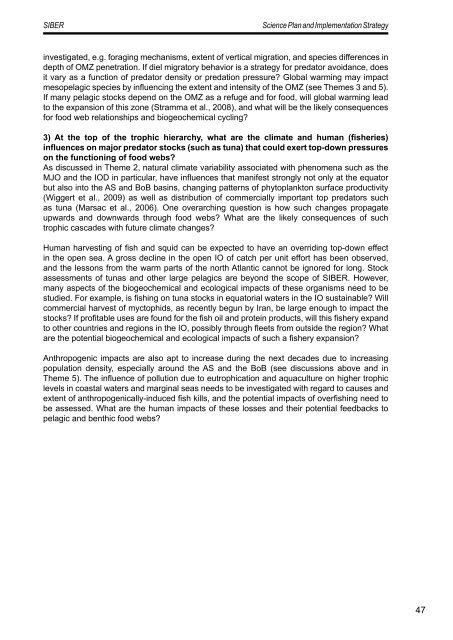SIBER SPIS sept 2011.pdf - IMBER
SIBER SPIS sept 2011.pdf - IMBER
SIBER SPIS sept 2011.pdf - IMBER
Create successful ePaper yourself
Turn your PDF publications into a flip-book with our unique Google optimized e-Paper software.
<strong>SIBER</strong><br />
Science Plan and Implementation Strategy<br />
investigated, e.g. foraging mechanisms, extent of vertical migration, and species differences in<br />
depth of OMZ penetration. If diel migratory behavior is a strategy for predator avoidance, does<br />
it vary as a function of predator density or predation pressure Global warming may impact<br />
mesopelagic species by influencing the extent and intensity of the OMZ (see Themes 3 and 5).<br />
If many pelagic stocks depend on the OMZ as a refuge and for food, will global warming lead<br />
to the expansion of this zone (Stramma et al., 2008), and what will be the likely consequences<br />
for food web relationships and biogeochemical cycling<br />
3) At the top of the trophic hierarchy, what are the climate and human (fisheries)<br />
influences on major predator stocks (such as tuna) that could exert top-down pressures<br />
on the functioning of food webs<br />
As discussed in Theme 2, natural climate variability associated with phenomena such as the<br />
MJO and the IOD in particular, have influences that manifest strongly not only at the equator<br />
but also into the AS and BoB basins, changing patterns of phytoplankton surface productivity<br />
(Wiggert et al., 2009) as well as distribution of commercially important top predators such<br />
as tuna (Marsac et al., 2006). One overarching question is how such changes propagate<br />
upwards and downwards through food webs What are the likely consequences of such<br />
trophic cascades with future climate changes<br />
Human harvesting of fish and squid can be expected to have an overriding top-down effect<br />
in the open sea. A gross decline in the open IO of catch per unit effort has been observed,<br />
and the lessons from the warm parts of the north Atlantic cannot be ignored for long. Stock<br />
assessments of tunas and other large pelagics are beyond the scope of <strong>SIBER</strong>. However,<br />
many aspects of the biogeochemical and ecological impacts of these organisms need to be<br />
studied. For example, is fishing on tuna stocks in equatorial waters in the IO sustainable Will<br />
commercial harvest of myctophids, as recently begun by Iran, be large enough to impact the<br />
stocks If profitable uses are found for the fish oil and protein products, will this fishery expand<br />
to other countries and regions in the IO, possibly through fleets from outside the region What<br />
are the potential biogeochemical and ecological impacts of such a fishery expansion<br />
Anthropogenic impacts are also apt to increase during the next decades due to increasing<br />
population density, especially around the AS and the BoB (see discussions above and in<br />
Theme 5). The influence of pollution due to eutrophication and aquaculture on higher trophic<br />
levels in coastal waters and marginal seas needs to be investigated with regard to causes and<br />
extent of anthropogenically-induced fish kills, and the potential impacts of overfishing need to<br />
be assessed. What are the human impacts of these losses and their potential feedbacks to<br />
pelagic and benthic food webs<br />
47












